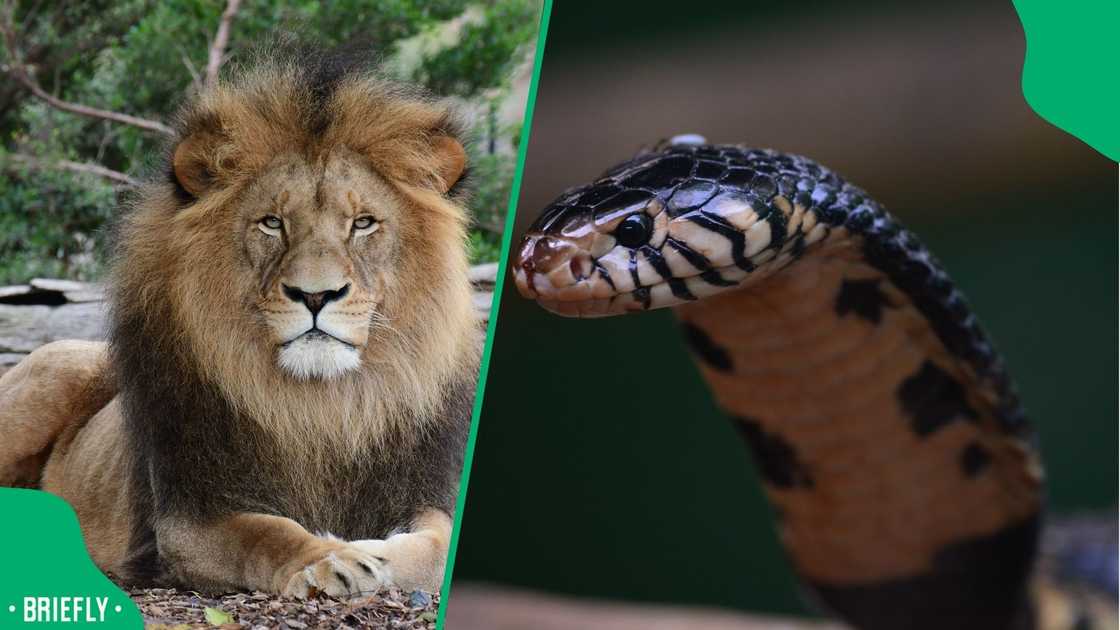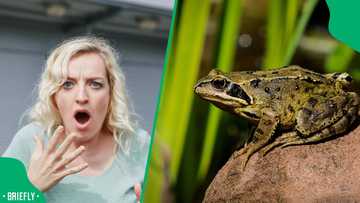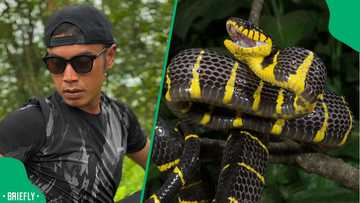“Mufasa vs Forest Cobra”: Lion Attacking Snake Doesn’t End Well in Scary Encounter
- A jaw-dropping video captured in Zimbabwe shows a curious lion approaching a defensive forest cobra, leading to a dangerous face-to-face confrontation between two deadly predators
- The footage reveals the moment the cobra strikes at the lion's face when the big cat gets too close, forcing the king of the jungle to quickly shield itself from the venomous attack
- Netizens were divided in their reactions, with some claiming the lion's fur would protect it while others insisted the deadly venom would prove fatal even to the powerful predator

Source: Getty Images
A gripping wildlife encounter between a lion and a forest cobra has captivated viewers across social media. Content creator @ComradeMasuku shared the footage from Zimbabwe, showing what happens when curiosity leads the king of the jungle into a potentially deadly situation.
The video captures a tense moment as the lion slowly approaches a forest cobra that has already assumed its defensive posture near a rock. The cobra, standing upright with its hood expanded, clearly issues a warning to the approaching predator. Despite the obvious threat display, the lion continues its advance, apparently viewing the snake as a potential target rather than a danger.
In a lightning-fast sequence, the cobra strikes first as the lion attempts to attack the snake's raised body. The venomous reptile manages to hit the lion's face, forcing the big cat to quickly shield itself from further strikes. The lion's reaction suggests it may have been bitten during the brief but intense encounter.
Watch the Facebook reel below.
PAY ATTENTION: stay informed and follow us on Google News!
Nature's deadly gamble
Forest cobras (Naja subfulva) are considered the largest cobras in Africa, capable of growing up to 2.7 meters in length. These snakes deliver a potent mix of neurotoxic and cytotoxic venom, capable of causing severe tissue damage, intense pain, swelling, and even respiratory failure if untreated. Their significant size allows them to inject substantial amounts of venom in a single strike.
Lions, usually focused on hunting large mammals, generally avoid confrontations with snakes. However, curiosity, territorial instincts, or accidental encounters can sometimes place them in harm’s way. Wildlife experts note that while lions possess thick fur that provides some protection against snake bites, a direct strike to areas with thinner fur or the face could potentially deliver enough venom to cause serious harm.
The outcome of such encounters depends on factors such as the bite’s location, the amount of venom injected, and whether the affected animal can receive medical intervention. In the wild, where treatment is unavailable, even a powerful predator like a lion could face fatal consequences from a venomous snake bite.

Read also
“I’ll never allow my child to go outside”: Kid surprises mom and dad with a frog, SA in stitches
Animal activist Jayshri Rangasamy spoke to Briefly News on how to keep animals and pets safe, stating:
In rural areas, pets face dangers such as encounters with wildlife like coyotes, raccoons, and snakes, exposure to poisonous plants like lilies and poison ivy, and limited access to veterinary care. In urban areas, risks include hot pavement, standing water with harmful bacteria, elevators, bird droppings carrying diseases, garbage on the streets, and high-rise hazards."
"To avoid snake encounters, research local species, stay on clear paths, keep your pet on a short leash, and avoid tall grass and rocky areas. If you see a snake, calmly move away and carry your pet if necessary. To avoid exposure to poisonous plants, familiarize yourself with toxic plants in your area, remove them from your home and garden, and supervise your pet when outdoors. These measures help maintain your pet's health and safety."

Source: Facebook
Divided opinions on the outcome
@Lifel Mairos expressed confidence in the lion's natural defenses:
"Remember, lions are in the cat family, so snakes are not a problem; the fur makes it harder for snakes to touch the veins."
@Eddie Nemukuyu joked about the lion's boldness:
"The king of the jungle is power drunk😂"
@Patrick Phaks predicted a grim outcome:
"That two-strike, I'm sure the lion is now dead."
@Ifeanyi Martins praised the lion's courage:
"That's exactly what makes him the king... He sees danger and still attacks."
@Okello Aaron shared a blunt assessment:
"That's a dead king there."
@Welcome Simelane explained the danger:
"The snake doesn't use weight to kill the lion. It uses poison. Just one bite, it's over."
More dangerous wildlife encounters
- An alarming video of a man swimming alongside a deadly king cobra left internet users horrified as the wildlife enthusiast held onto the massive reptile's body while carefully avoiding its dangerous head.
- A couple faced unexpected criticism after rescuing a baby deer from the clutches of a giant python, with many social media users arguing they should have allowed nature to take its course despite their good intentions.
- Briefly News also reported on a Free State woman's nighttime encounter with a puff adder that resulted in a horrifying snake bite that left South Africans deeply concerned after seeing the graphic aftermath photos shared on Facebook.
Source: Briefly News

Nerissa Naidoo (Human Interest Editor) Nerissa Naidoo is a writer and editor with seven years of experience. Currently, she is a human interest writer at Briefly News and joined the publication in 2024. She began her career contributing to Morning Lazziness and later joined Featherpen.org. As a TUW ghostwriter, she focused on non-fiction, while her editorial roles at National Today and Entail.ai honed her skills in content accuracy and expert-driven editing. You can reach her at nerissa.naidoo@briefly.co.za

Jayshri Rangasamy (Medical Scientist - Pharmacologist - Clinical Team Lead) Jayshri Rangasamy, Fortrea's Clinical Operations Delivery Leader, oversees the company's Clinical Team. She has extensive experience in both infectious diseases (tuberculosis, Ebola, COVID-19) and non-infectious diseases (cardiovascular, endocrinology, and gastroenterology), as well as oncology (lung cancer, hematologic malignancies). Rangasamy, who holds a MS and BS in Pharmacology and Human Physiology from the University of Pretoria, is an advocate for empathetic leadership. She's also a certified Latin and ballroom dancer.


